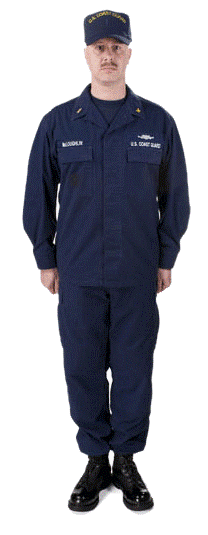Operational Dress Uniform

The Operational Dress Uniform (ODU) is the normal work uniform of the United States Coast Guard and the United States Coast Guard Auxiliary.
The Coast Guard introduced the new "Operational Dress Uniform" (ODU) uniform in 2004 to replace the winter and summer "Undress Duty" uniform. Resembling law enforcement SWAT fatigues, the ODU uniform resembles the old-style Battle Dress Uniforms, but with the lower pockets on the blouse being eliminated and the uniform being worn tucked into the trousers, similar in nature to the old-style Cold War-era fatigues. The sleeves can be worn folded up and the trousers bloused above the boots, with the ODU black belt and blackened buckle (also referred to as a rigger's belt) being worn with the metal tip 2 to 4 inches from the buckle. A dark blue Coast Guard unit ballcap is worn with this uniform. The ODU also has all of its insignia sewn on, eliminating the chance of puncture wounds created by the pins if an individual suffers a blow to the chest while wearing a PFD.
In 2008, a new version of the ODU, which featured an untucked blouson, was approved and is gradually replacing the tucked version through 2012. The untucked blouse bears the Coast Guard insignia on the breast pocket, and is worn with trousers featuring the same Coast Guard insignia on the cargo pockets.
Coast Guard units that engage in combat operations generally wear the Camouflage Utility Uniform (CUU) in a woodland or desert pattern and color scheme rather than ODUs.
A 2006 issue of the Reservist magazine was devoted to a detailed and easy-to-understand graphical description of all the authorized uniforms.
In 2008, ODU's were authorized for wear by the Commissioned Officer Corps of the National Oceanic and Atmospheric Administration. The uniform replaces the U.S. Navy working khakis NOAA officers formerly wore. Sewn on insignia is worn in a fashion similar to the Coast Guard.
